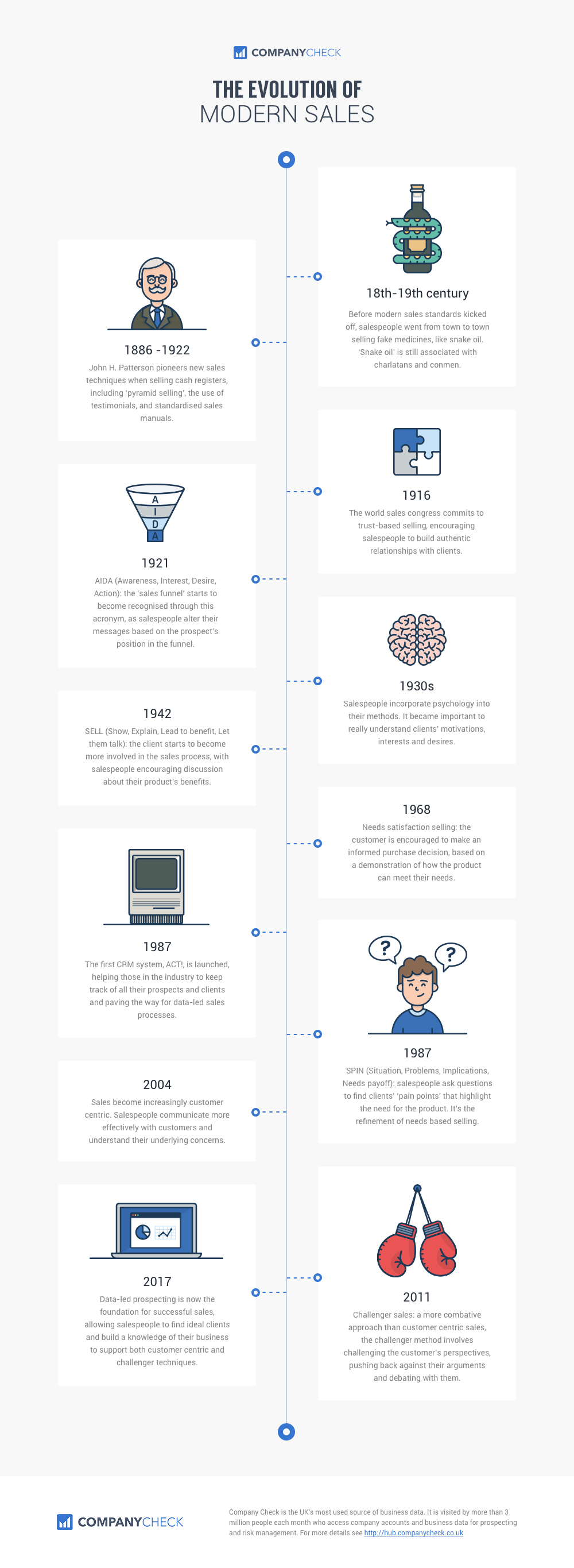Why do we sell the way we do? Modern sales techniques have been honed over centuries of trial and error. According to a new infographic from Company Check, sales techniques and processes have been evolving over time.
Broadly speaking, there are two trends in modern sales, Katie Deverill, operations manager at Company Check tells GrowthBusiness. One is the increasing focus of gaining consumer trust and the other is the rise of data and research as tools to make sales techniques more effective.
“Both challenger sales techniques and data-led prospecting show the most recent outcomes of these trends. Challenger sales methods may not build trust in a conventional way – throwing ‘the customer is always right’ out of the window – but the end goal is still to convince the customer that they can trust the salesperson’s expertise because of their depth of knowledge,” she says. “Similarly, data-led targeting methods rely on using data sources like Company Check to identify the best prospects, allowing a natural relationship to form more quickly as you demonstrate the usefulness of your offering.”
Deverill expects efforts to improve and build on these techniques in the future to continue operating within the sales paradigm that has been in place since the early 20th century. But with more granular targeting thanks to cloud-based CRM systems, continued access to business data and the availability of information through social media and content platforms. The sales methods of the future will refine prospecting to ensure that pitches have a high chance of success, increasing the efficiency of sales teams, she explains.
She also points to an important trend in the sales landscape; the increasing diversity of the profession in the Western world. “The latest stats from the US suggest that women make up 49 per cent of people in sales-related occupations, as well as holding 45.3 per cent of sales and marketing manager roles. I don’t have any equivalent statistics for the UK, but we do know that just under half of our workforce is made up of women and that Fortune 500 boards with a high number of female board members have, on average, a 16 per cent higher return on sales than the lowest quartile,” she says.
The old, stereotypical image of a salesman is past its sell-by date, says Deverill. The Fortune 500’s ROS statistics suggest that the presence of more women in a business is a positive thing for that company’s bottom line and a diverse sales team will benefit from the range of sales styles that it will contain.
“Alongside developing methodologies, business leaders would be wise to intentionally create a diverse, multi-talented sales team, in which individual opinions are heard and valued. This will allow teams to be versatile and responsive to whatever course their data indicates, which can then be acted upon by whoever’s sales style is best suited to the client at hand,” she adds. “I can’t see businesses that stick to rigid and old-fashioned sales models succeeding in the years to come; business in general is becoming more diverse in all sorts of ways and sales teams will only benefit from reflecting those changes.”
Company Check’s infographic below outlines the evolution of modern sales.








